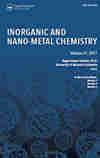Development of New Fluorescent Dyes by Using Amine Modified Nanoparticles for Immunostaining
Synthesis and Reactivity in Inorganic, Metal-Organic, and Nano-Metal Chemistry
Pub Date : 2016-05-16
DOI:10.1080/15533174.2015.1137062
引用次数: 0
Abstract
Fluorescent labeling of DNA was studied by using two newly synthesized ligands, which are 4-(2-hydroxybenzylidinamino) benzoic acid (PHBA) and 4-(2-hydroxybenzylidinamino) phthalic acid (PHPA). Their binding capacity to calf-thymus DNA was determined on functionalized superparamagnetic iron oxide nanoparticles (SPIONs). 23.1 µg of DNA was immobilized on 25 mg of nanoparticles. Binding capacity of fluorescent ligands to DNA-APTS-SPIONs was also found as 2.36 µM for PHBA and 1.97 for PHPA at 25 mg of the nanoparticles. Binding of the DNA to the ligands were examined by scanning electron microscopy, transmission electron microscopy, infrared spectroscopy, and confocal microscopy.胺修饰纳米颗粒免疫染色荧光染料的研制
采用新合成的4-(2-羟基苄基氨基)苯甲酸(PHBA)和4-(2-羟基苄基氨基)邻苯二甲酸(PHPA)两种配体对DNA的荧光标记进行了研究。在功能化的超顺磁性氧化铁纳米颗粒(SPIONs)上测定了它们与小牛胸腺DNA的结合能力。23.1µg DNA固定在25mg纳米颗粒上。荧光配体与DNA-APTS-SPIONs的结合能力在25 mg时,PHBA和PHPA的结合能力分别为2.36µM和1.97µM。通过扫描电子显微镜、透射电子显微镜、红外光谱和共聚焦显微镜检查DNA与配体的结合。
本文章由计算机程序翻译,如有差异,请以英文原文为准。
求助全文
约1分钟内获得全文
求助全文
来源期刊
自引率
0.00%
发文量
0
审稿时长
5 months

 求助内容:
求助内容: 应助结果提醒方式:
应助结果提醒方式:


